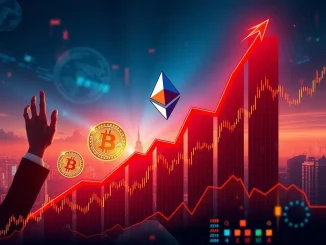
Hold onto your hats, crypto enthusiasts! The Solana blockchain, once a darling of the DeFi summer and memecoin frenzy, is experiencing a dramatic downturn. Recent reports indicate a *shocking* 93% plunge in Solana’s weekly revenue since mid-January. This massive drop has sent ripples through the crypto community, raising questions about the network’s sustainability and future growth. Let’s dive deep into what’s causing this significant decline in Solana revenue and what it means for the broader crypto landscape.
The Alarming Solana Revenue Plunge: A Deep Dive
The numbers are stark. Solana’s revenue, a key indicator of network activity and health, has plummeted from a robust figure in mid-January to a mere $4 million recently. This represents the lowest weekly revenue for the Solana network since September of last year. To put it in perspective, a 93% decrease is not just a dip; it’s a near-vertical fall. This drastic reduction raises immediate concerns about the factors driving users away from the Solana ecosystem and impacting its financial performance.
Here’s a quick snapshot of the decline:
| Metric | Mid-January | Current | Change |
|---|---|---|---|
| Weekly Network Revenue | Significantly Higher (Implied) | $4 Million | -93% |
| DeFi TVL | $12 Billion | $6.4 Billion | -46.6% |
As you can see, the revenue decline is mirrored by a significant drop in another crucial metric: Total Value Locked (TVL) in Decentralized Finance (DeFi). Let’s explore this further.
DeFi TVL Takes a Nosedive: Are Users Losing Faith?
Alongside the revenue crash, DeFi TVL on the Solana network has also suffered a major blow. It has nearly halved since mid-January, dropping from a substantial $12 billion to $6.4 billion. This exodus of capital from Solana’s DeFi ecosystem is a worrying sign. TVL is often considered a barometer of investor confidence and platform utility within the DeFi space. A shrinking TVL can indicate several things, including:
- Reduced User Activity: Less TVL can mean fewer users are engaging with DeFi protocols on Solana.
- Capital Flight: Investors may be withdrawing their assets and moving them to other blockchains or risk-off assets.
- Decreased Liquidity: Lower TVL can lead to reduced liquidity within DeFi protocols, potentially making transactions more difficult and impacting yields.
The near 50% decrease in DeFi TVL paints a picture of waning confidence and potentially reduced attractiveness of Solana’s DeFi offerings compared to earlier this year.
Memecoin Mania Fades: The Ripple Effect on Solana
The prevailing theory behind these declines points towards the fading frenzy surrounding memecoins. Remember the explosive growth of memecoins on Solana earlier in the year? These tokens, often driven by social media hype and community sentiment rather than fundamental value, can generate significant network activity and transaction fees. However, memecoin trends are notoriously volatile and short-lived. As the hype surrounding these speculative assets cools down, so does the associated network activity. Cointelegraph, in its report, directly attributes the revenue and TVL drops to this “waning interest in memecoins.”
Here’s how the memecoin factor might be impacting Solana:
- Reduced Transaction Volume: Memecoin trading often involves high volumes of transactions, generating fees for the network. Less memecoin activity means fewer transactions and lower fees.
- Decreased On-Chain Activity: Memecoin projects and communities contribute to overall on-chain activity, including token swaps, liquidity provision, and more. A decline in memecoin interest translates to less activity across the board.
- Shifting Focus: Users and developers might be redirecting their attention and resources to other sectors within the crypto space, moving away from the speculative memecoin market.
What Does This Mean for the Solana Network’s Future?
The 93% revenue plunge is undoubtedly a significant challenge for the Solana network. However, it’s crucial to maintain perspective. The crypto market is cyclical, and periods of rapid growth are often followed by corrections and consolidations. While the memecoin-driven boom might be over for now, Solana’s underlying technology and ecosystem still hold considerable potential.
Here are some key considerations for Solana’s future:
- Focus on Core Utility: Solana needs to double down on building and promoting real-world use cases beyond memecoins. This includes attracting more DeFi projects with sustainable value propositions, fostering NFT communities with long-term vision, and exploring enterprise applications.
- Developer Ecosystem Growth: A strong and active developer community is vital for any blockchain’s long-term success. Solana must continue to support and incentivize developers to build innovative applications on its platform.
- Network Stability and Scalability: Solana has faced challenges with network congestion and outages in the past. Addressing these issues and ensuring consistent network stability is crucial for regaining user trust and attracting institutional adoption.
- Community Engagement: Maintaining a vibrant and engaged community is essential. Solana needs to actively communicate with its users, listen to feedback, and foster a sense of shared ownership in the network’s future.
Understanding the Broader Crypto Context
It’s important to remember that Solana is not alone in facing market fluctuations. The entire crypto market is subject to volatility and external factors. While the SOL revenue decline is concerning, it’s crucial to analyze it within the broader context of market trends and competitive dynamics. Other blockchains are also vying for dominance in the DeFi and NFT spaces, and user attention is constantly shifting.
Key Takeaways:
- Volatility is Inherent: The crypto market is inherently volatile, and dramatic price swings and shifts in network activity are to be expected.
- Diversification is Key: Relying heavily on speculative trends like memecoins can be risky. A diversified ecosystem with a mix of use cases is more resilient in the long run.
- Innovation and Adaptation: Blockchains must continuously innovate and adapt to evolving market demands and user needs to remain competitive.
Conclusion: Solana’s Path Forward After the Revenue Crash
Solana’s 93% revenue crash is a wake-up call, highlighting the risks of relying on fleeting trends and the importance of building sustainable ecosystems. While the immediate outlook may seem challenging, Solana still possesses significant technological advantages and a dedicated community. The path forward requires a renewed focus on core utility, developer support, network stability, and community engagement. Whether Solana can successfully navigate this downturn and emerge stronger remains to be seen, but the crypto world will be watching closely. The DeFi summer might be cooling down, but the blockchain winter could be the perfect time for builders to lay the foundation for a more robust and sustainable future for Solana and the broader crypto space.



